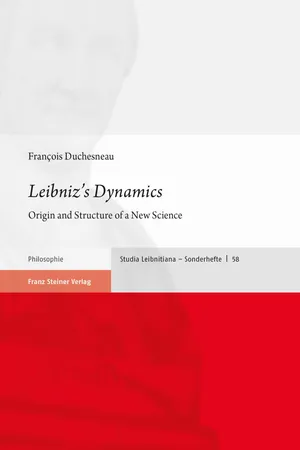
- 257 pages
- English
- PDF
- Available on iOS & Android
About this book
Gottfried Wilhelm Leibniz (1646–1716) launched a new science dedicated to the theory of force. His "dynamics" is an important episode in the history of the scientific revolution. Its starting point has been a particular theory of the combination of motions placed within the framework of a mechanistic natural philosophy. Its turning point was Leibniz's discovery in 1678 of a new principle later known as principle of conservation of live force, which he proposed in 1686 as replacement for Descartes' principle of conservation of quantity of motion. In Dynamica de potentia (1689–90), Specimen dynamicum (1695), Essay de dynamique (ca. 1700), and various pieces of correspondence, Leibniz applied his creative methodology, fostered original scientific models and hypotheses, and refined demonstrative arguments in support of his theory. As a result, the dynamics would comprise the conceptual and architectonic fundamental elements for a revised "system of nature". Our endeavor has been to unveil the genesis and explain the makeup of this Leibnizian scientific and philosophical achievement.
Frequently asked questions
- Essential is ideal for learners and professionals who enjoy exploring a wide range of subjects. Access the Essential Library with 800,000+ trusted titles and best-sellers across business, personal growth, and the humanities. Includes unlimited reading time and Standard Read Aloud voice.
- Complete: Perfect for advanced learners and researchers needing full, unrestricted access. Unlock 1.4M+ books across hundreds of subjects, including academic and specialized titles. The Complete Plan also includes advanced features like Premium Read Aloud and Research Assistant.
Please note we cannot support devices running on iOS 13 and Android 7 or earlier. Learn more about using the app.
Information
Table of contents
- Title
- Impressum
- Acknowledgments
- Table of Contents
- Introduction
- Chapter I The Initial Scientific Project
- Chapter II Reforming Mechanics
- Chapter III The Structure of Dynamics
- Chapter IV The a priori Analytic Model
- General Conclusion
- Bibliography
- Index